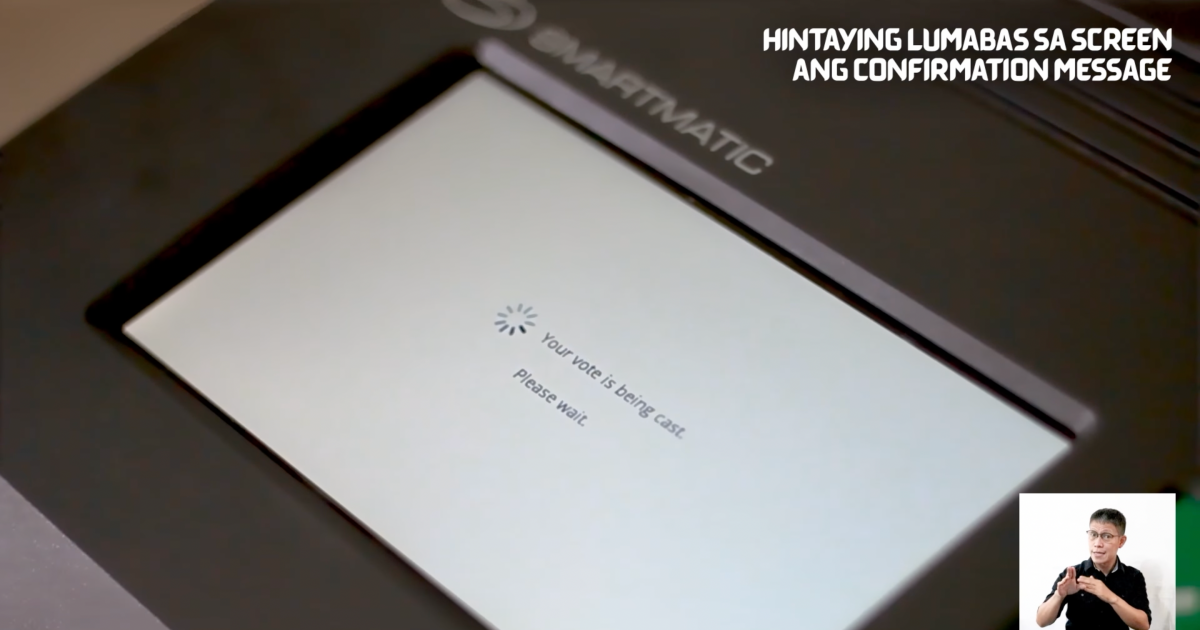From paper to server: How do the May 9 automated elections work and when will the results be out?

The May 9 elections is just around the corner, and the Commission on Elections (Comelec) has been making sure that it's all systems go on D-Day.
That fateful voting day, like in the past years, will use an automated system. So what happens in an automated election system?
Simply put, a voter accomplishes a ballot, feeds it to a vote-counting machine (VCM) for scanning which then processes its output and electronically transfers the data to Comelec's servers.
It's seen as more efficient than manual counting, in which poll officials tally the written names of officials by hand. The three-day local absentee voting last April 27 to 29 was held manually.
As of May 3, Comelec said 106,000 VCMs, as well as 1,000 backup units, have been distributed across the country. Of that number, 10,000 VCMs were leased for the upcoming elections and 97,000 were from the past elections that underwent refurbishment.
Each VCM has an SD card which contains instructions on the counting of the ballots.
From May 2 to 7, the poll body has been conducting final testing and sealing of VCMs to ensure that election day would be running like clockwork.
So far, 355 VCMs have been replaced due to defects. The defective VCMs are being repaired in Comelec's warehouse in Sta. Rosa in Laguna in time for May 9. A total of 44 defective SD cards have also been replaced.
Prior to that, Comelec also staged several demos in malls nationwide to inform the public how the machines work.

After minutes of shading ovals, voters would have to feed their ballots to the VCM by themselves while the precinct's assigned chairperson oversees the process. Just so one's votes are counted, they must only use the marking pens provided by Comelec and fully shade the entire oval—not x-mark, check, or half-shade—beside a candidate’s name. They must not also put unnecessary markings on the ballot.
While shading, voters must ensure that they're not overvoting in a position, lest it would nullify their vote. One, however, may opt to undervote or abstain.
The machine will verify the ballot inserted and generate a receipt afterward. Voters are encouraged to double check if the receipt matches their votes before dropping it to the designated box. Pocketing the receipts aren't allowed.
Voting data will be stored in the VCM's SD cards and get uploaded to Comelec's servers throughout the day.

Comelec's main server is located at the Bonifacio Global City in Taguig. It has transparency server for political parties in Sucat in Parañaque, and a media server for reporters in the University of Santo Tomas in Manila. In case of emergency, the poll body has a back-up server in Libis in Eastwood, Quezon City.
The facilities where the servers are located are all ISO-certified for quality assurance.
Twelve political parties are allowed access to the transparency server, alongside various poll watchdogs:
- PDP-Laban
- National Unity Party
- Aksyon Demokratiko
- Partido Federal ng Pilipinas
- Nacionalista Party
- Liberal Party
- United Nationalist Alliance
- Lakas-Christian Muslim Democrats
- Nationalist People’s Coalition
- Partido Para sa Demokratikong Reporma
- Akbayan Citizens’ Action Party
- Laban ng Demokratikong Pilipino
As for media personnel, Comelec accredited eight television networks, four radio stations, five newspapers, and three online news websites:
Television
- ABS-CBN
- CNN
- Net25
- TV5
- PTV4
- SMNI
- UNTV
- GMA
Radio
- Bombo Radyo
- FEBC
- DZBB
- MBC
Newspaper
- Manila Bulletin
- Philippine Daily Inquirer
- Philippine Star
- Manila Standard
- Daily Tribune
Online news website
- Inquirer Interactive
- Philstar.com
- Rappler
Like before, Comelec said the transmission of results from the VCMs to its transparency server is real-time, though transmission of results to the media server has a 15-minute interval.
To ensure security, Comelec said activities in the room where the transparency server is installed will be livestreamed on its official pages.
In light of the so-called "seven-hour glitch" in the 2019 midterm elections—which saw interruption in the sending of canvassed votes from Comelec's transparency server to the media server—and cast doubts on that year's results, Comelec said it subjected the system to a "stress test."
In the stress test, Comelec sent 100,000 and 50,000 results at a time from the transparency server to the media server, and the load of data this time around, it said, didn't cause any malfunction to the system.

As for the results, Comelec Commissioner George Garcia said the partial and unofficial count for president and vice president will be known "by the seventh day" after polls close on May 9.
“By the seventh day we can already see the winning president and vice president based on partial and unofficial results,” Garcia said.
According to Garcia, basing from the country's experience since the 2010 elections, winning senators may be proclaimed as early as May 15, while winners of local positions may be announced as early as the evening of May 9 itself.
Counting and canvassing of the manual local absentee voting will also take place at Comelec's main office in Intramuros in Manila.
The Congress, meanwhile, will canvass the votes once the Senate and the House of Representatives resume sessions on May 23. It hopes for a "speedy canvass" by June 3, when it will adjourn its third and last regular session.
“We will have the proclamation of the president by the first week of June,” Garcia said.


